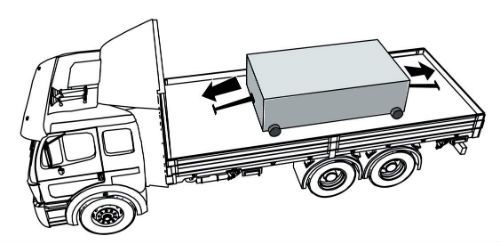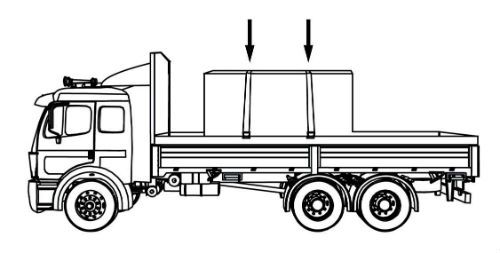CDL Practice Tests: Flatbed Cargo Securement
Choose A Section:
Go!When securing concrete pipe up to 45 inches loaded crosswise, tiedowns through the pipe must be:
- Wire.
- Nylon rope.
- Chains
- Straps.
Tiedown requirements
- Pipe may be secured individually or as a group.
- Tiedowns through the pipe must be chains.
- Front-to-back tiedowns may be chain or wire rope.
A stack of shortwood loaded lengthwise can be secured with one tiedown if:
- All of these apply.
- All logs in the stack are less than 10 ft long.
- They are blocked in the back by the vehicle's end structure or another stack of logs.
- They are blocked in the front by a headboard or another stack of logs.
One tiedown
A stack can be secured with one tiedown if all logs in the stack less than 3.04 m (10 ft) are:
- Blocked in the front by a headboard strong enough to restrain the load or by another stack of logs.
- Blocked in the rear by the vehicle's end structure or another stack of logs.
Which of the following is not a reason why loads should be secured?
- Prevent damage to the cargo
- Avoid fines and citations
- Make it look pretty
- Prevent loss of load
Why secure your load? To prevent:
- Loss of life
- Loss of load
- Damage to the cargo
- Damage to the vehicle
- Issuance of citations/fines to driver/carrier
- The vehicle being placed Out-of-Service.
- A crash
In cargo securement, what is a 'cleat' defined as?
- Part of the structure, fitting, or attachment on a vehicle or cargo to which a tiedown is attached.
- A tapered or wedge-shaped piece used to secure round articles against rolling.
- A short piece of material, usually wood, nailed to the deck to reinforce blocking.
- A tapered piece of material, thick at one end and thin at the other.
Cleat:
A short piece of material, usually wood, nailed to the deck to reinforce blocking.
A sided vehicle containing cargo weighing 35,980 lbs must be able to withstand a rearward force of at least:
- 10,000 lbs
- 17,990 lbs
- 36,000 lbs
- 28,784 lbs
Note: If the cargo is contained in a sided vehicle, the vehicle structure MUST be strong enough to withstand the forces described earlier.
- Forward force: 0.8 g (80%)
- Rearward force: 0.5.g (50%)
- Sideways force: 0.5 g (50%)
When securing flattened or crushed cars on a vehicle with containment on 2 sides, how many tiedowns, at minimum, are required?
- 4
- 1
- 2
- 3
Option 3:
Has containment walls on two sides that:
- Extend to the full height of the load.
- Block against cargo movement in the forward and rearward.
Secures each stack of vehicles with a minimum of three tiedowns, each having a minimum WLL of 2,268 kg (5,000 lb.).
All of these are requirements for securing longwood lengthwise except:
- Must be cradled in two or more bunks or contained by stakes.
- Each outside log should bear against at least two stakes, one near each end of the log.
- Secure each log with at least two tiedowns if shorter logs are carried on top of the stack.
- Each end of the log should extend at least 3 inches beyond the stakes.
Requirements for securing longwood loaded lengthwise
- Longwood must be cradled in two or more bunks or contained by stakes.
- Each outside log should bear against at least two stakes, one near each end of the log.
- Each end of the log should extend at least 0.15 m (6 in) beyond the stakes.
- If shorter logs are carried on top of the stack, secure each log with at least two tiedowns.
When securing paper rolls with eyes crosswise, which of the following can be used to prevent side-to-side shifting when there is more than 8 inches of space to the wall?
- Any of these methods are acceptable.
- Friction mats.
- Void fillers.
- Tiedowns.
Requirements for eyes crosswise: prevent rolls from shifting toward either wall
If there is more than a total of 203 mm (8 in) of space between the ends of a paper roll and other rolls or the walls of the vehicle, use one of these methods:
- Void fillers (such as honeycomb)
- Blocking
- Bracing
- Friction mats
- Tiedowns
When securing an intermodal container on a chassis, what is the maximum allowable vertical travel when secured?
- 1 inch
- 1/2 inch
- 2 1/2 inches
- 2 inches
Securing devices must restrain the container from moving more than:
- 1.27 cm (1/2 in) forward.
- 1.27 cm (1/2 in) rearward.
- 1.27 cm (1/2 in) to the right.
- 1.27 cm (1/2 in) to the left.
- 2.54 cm (1 in) vertically.
Cargo securement for a load weighing 37,000 lbs must be able to withstand a minimum forward braking force of:
- 7,400 lbs
- 29,600 lbs
- 18,500 lbs
- 10,000 lbs
How well must the securement system work? (Section 1.3)
Each cargo securement system must be able to withstand a minimum amount of force in each direction.
- Forward Force = 80% of cargo weight when braking while driving straight ahead.
- Rearward Force = 50% of cargo weight when accelerating, shifting gears while climbing a hill, or braking in reverse.
- Sideways Force = 50% of cargo weight when turning, changing lanes, or braking while turning.
-
Upward Force = 20% of cargo weight when traveling over bumps in the road or cresting a hill.
- This requirement is satisfied when the cargo is "Fully Contained."
About The Flatbed Cargo Securement CDL Manual
Studying the flatbed cargo securement CDL manual is not a requirement for getting your CDL permit or license. It is required knowledge for flatbed drivers.
Some questions you should be able to answer for flatbed cargo securement:
- What is the minimum Working Load Limit of a tiedown used to secure logs?
- What is the minimum weight of a shipment of paper rolls that would require specific securement requirements?
- When securing concrete pipe over 45 inches loaded crosswise, which direction must the tiedowns on the front half of the load run?
- What is a cab shield?
- When securing concrete pipe over 45 inches loaded crosswise, which direction must the tiedowns on the rear half of the load run?
- What is a dunnage bag?
- Who is responsible for inspecting securing devices and cargo within the first 50 miles?
- How many tiedowns are required on a stack of shortwood loaded crosswise?
- What is the minimum working load limit of each tiedown used to secure crushed or flattened vehicles?
- Define 'bolster'
- What is a hook-lift container?
- When a tiedown is attached directly to the cargo, what is the ideal angle where it attached to the vehicle?
What is a securing device?
Any device specifically manufactured to attach or secure cargo to a vehicle or trailer:
- Synthetic Webbing
- Chain
- Wire rope
- Manila rope
- Synthetic rope
- Steel strapping
- Clamps and latches
- Blocking
- Front-end structure
- Grab hooks
- Binders
- Shackles
- Winches
- Stake pockets
- D-rings
- Webbing ratchet
- Bracing
- Friction mat
What is a tiedown?
A combination of securing devices that forms an assembly that:
- Attaches cargo to, or restrains cargo on a vehicle.
- Is attached to anchor point(s).

Some tiedowns are attached to the cargo and provide direct resistance to restrain the cargo from movement.

Some tie-downs pass over or through the cargo. They create a downward force that increases the effect of friction between the cargo and the deck. This friction restrains the cargo.
 Related Cargo Securement Terms That Every Driver Should Know:
Related Cargo Securement Terms That Every Driver Should Know:
-
Tiedown:
A combination of securing devices which form an assembly that attaches cargo to, or restrains cargo on, a vehicle or trailer, and is attached to anchor point(s).
-
Contained:
Cargo is contained if it fills a sided vehicle, and every article is in contact with or sufficiently close to a wall or other articles so that it cannot shift or tip if those other articles are also unable to shift or tip.
-
Blocking:
A structure, device, or another substantial article placed against or around an article to prevent horizontal movement of the article.
How should tiedowns be attached?
Tiedowns can be used in two ways:
-
Attached to the cargo:
- Tiedowns attached to the vehicle and attached to the cargo.
- Tiedowns attached to the vehicle, pass through or aroundan article of cargo, and then are attached to the vehicle again.
-
Pass over the cargo:
- Tiedowns attached to the vehicle, passed over the cargo, and then attached to the vehicle again.
Tiedown placement:

Place the tiedown as close as possible to the spacer.
Position the tiedowns as symetrically as possible over the length of the article.

Position the tiedowns to preserve the integrity of the article.







 TT On Facebook
TT On Facebook